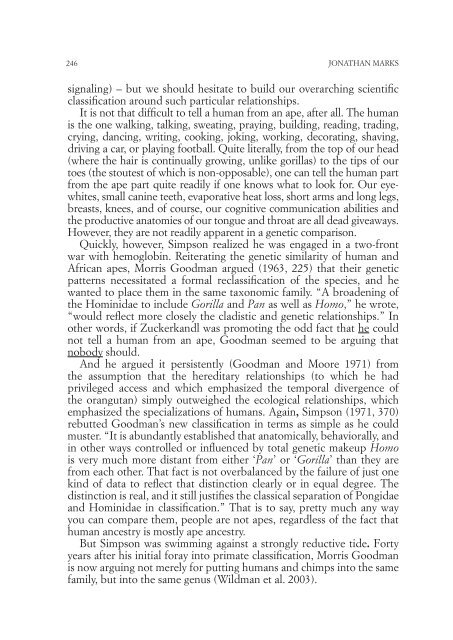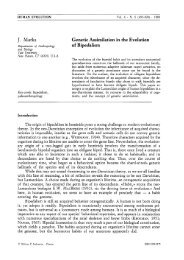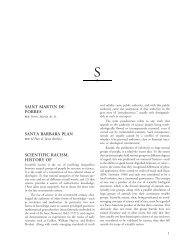What is the Viewpoint of Hemoglobin, and Does It Matter?
What is the Viewpoint of Hemoglobin, and Does It Matter?
What is the Viewpoint of Hemoglobin, and Does It Matter?
- No tags were found...
Create successful ePaper yourself
Turn your PDF publications into a flip-book with our unique Google optimized e-Paper software.
246 jonathan markssignaling) – but we should hesitate to build our overarching scientificclassification around such particular relationships.<strong>It</strong> <strong>is</strong> not that difficult to tell a human from an ape, after all. The human<strong>is</strong> <strong>the</strong> one walking, talking, sweating, praying, building, reading, trading,crying, dancing, writing, cooking, joking, working, decorating, shaving,driving a car, or playing football. Quite literally, from <strong>the</strong> top <strong>of</strong> our head(where <strong>the</strong> hair <strong>is</strong> continually growing, unlike gorillas) to <strong>the</strong> tips <strong>of</strong> ourtoes (<strong>the</strong> stoutest <strong>of</strong> which <strong>is</strong> non-opposable), one can tell <strong>the</strong> human partfrom <strong>the</strong> ape part quite readily if one knows what to look for. Our eyewhites,small canine teeth, evaporative heat loss, short arms <strong>and</strong> long legs,breasts, knees, <strong>and</strong> <strong>of</strong> course, our cognitive communication abilities <strong>and</strong><strong>the</strong> productive anatomies <strong>of</strong> our tongue <strong>and</strong> throat are all dead giveaways.However, <strong>the</strong>y are not readily apparent in a genetic compar<strong>is</strong>on.Quickly, however, Simpson realized he was engaged in a two-frontwar with hemoglobin. Reiterating <strong>the</strong> genetic similarity <strong>of</strong> human <strong>and</strong>African apes, Morr<strong>is</strong> Goodman argued (1963, 225) that <strong>the</strong>ir geneticpatterns necessitated a formal reclassification <strong>of</strong> <strong>the</strong> species, <strong>and</strong> hewanted to place <strong>the</strong>m in <strong>the</strong> same taxonomic family. “A broadening <strong>of</strong><strong>the</strong> Hominidae to include Gorilla <strong>and</strong> Pan as well as Homo,” he wrote,“would reflect more closely <strong>the</strong> clad<strong>is</strong>tic <strong>and</strong> genetic relationships.” Ino<strong>the</strong>r words, if Zuckerk<strong>and</strong>l was promoting <strong>the</strong> odd fact that he couldnot tell a human from an ape, Goodman seemed to be arguing thatnobody should.And he argued it pers<strong>is</strong>tently (Goodman <strong>and</strong> Moore 1971) from<strong>the</strong> assumption that <strong>the</strong> hereditary relationships (to which he hadprivileged access <strong>and</strong> which emphasized <strong>the</strong> temporal divergence <strong>of</strong><strong>the</strong> orangutan) simply outweighed <strong>the</strong> ecological relationships, whichemphasized <strong>the</strong> specializations <strong>of</strong> humans. Again, Simpson (1971, 370)rebutted Goodman’s new classification in terms as simple as he couldmuster. “<strong>It</strong> <strong>is</strong> abundantly establ<strong>is</strong>hed that anatomically, behaviorally, <strong>and</strong>in o<strong>the</strong>r ways controlled or influenced by total genetic makeup Homo<strong>is</strong> very much more d<strong>is</strong>tant from ei<strong>the</strong>r ‘Pan’ or ‘Gorilla’ than <strong>the</strong>y arefrom each o<strong>the</strong>r. That fact <strong>is</strong> not overbalanced by <strong>the</strong> failure <strong>of</strong> just onekind <strong>of</strong> data to reflect that d<strong>is</strong>tinction clearly or in equal degree. Thed<strong>is</strong>tinction <strong>is</strong> real, <strong>and</strong> it still justifies <strong>the</strong> classical separation <strong>of</strong> Pongidae<strong>and</strong> Hominidae in classification.” That <strong>is</strong> to say, pretty much any wayyou can compare <strong>the</strong>m, people are not apes, regardless <strong>of</strong> <strong>the</strong> fact thathuman ancestry <strong>is</strong> mostly ape ancestry.But Simpson was swimming against a strongly reductive tide. Fortyyears after h<strong>is</strong> initial foray into primate classification, Morr<strong>is</strong> Goodman<strong>is</strong> now arguing not merely for putting humans <strong>and</strong> chimps into <strong>the</strong> samefamily, but into <strong>the</strong> same genus (Wildman et al. 2003).




